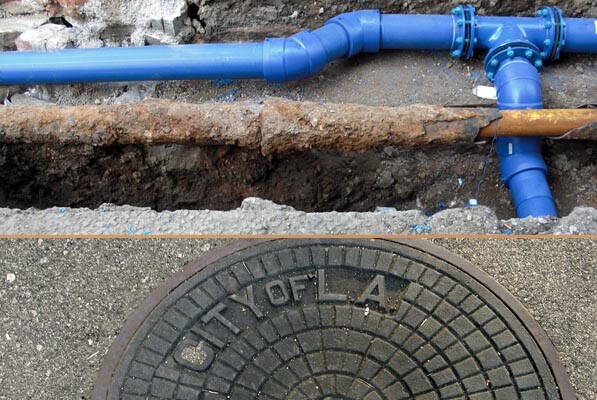Water, electricity, sewer rates going up in aging L.A.

Forever young. Los Angeles still sells itself to the world with that increasingly ironic branding. Yet for most of the 20th century, it was true. Because our urbanization began only in the late 1880s, Los Angeles was still youthful when other cities began to crumble in the 1970s. Even the climate cooperated. It didn't gnaw at public facilities the way the weather did "back East.".
But nothing lasts, even in a presumed paradise. Los Angeles is wearing out. Sidewalks, streets, water mains, and sewers constructed in the past 100 years need replacement, not just the usual patch-up repair.
Renewing the city's infrastructure will be costly, and deficit-riddled Los Angeles doesn't have the money.
There's a mob of reasons why. Some are structural: revenue limits imposed by voters that uncoupled property taxes from inflation and made the adoption of tax increases subject to a super majority. Some reasons are the result of recessions, which always come at the wrong time. And some are the result of city council and mayoral inattention.
Sewers and water mains - the infrastructure you can't see - are easiest for everyone to forget until the bill for forgetfulness comes due. It has. Both the Bureau of Sanitation (sewers and storm drains) and the Department of Water and Power (water mains and electricity) are seeking city council authority to begin a series of significant rate increases for households and consumers.
The most likely outcome is a 6.5 percent increase in sewer fees each year for three years followed by a 7.5 percent increase each year for the next two years. Sewer bills would go from about $30 a month to nearly $42 a month by 2015. Water rates would increase 15.3 percent and electricity would go up by 16.8 percent, both over a three-year period. According to DWP calculations, a "typical family" would have $2.24 added to their monthly water bill in each of the next three years and another $4.04 a month for electricity.
But that won't be nearly enough. Half the city's 6,700-mile sewer system is nearing the end of its usable life, when repairs become more costly than replacement; 20 percent of the system is decades beyond that point-of-no-return. The city's power grid and water distribution system face the same bleak calculation.
As a matter of spin, city officials like to point out that property owners and water and power consumers in Los Angeles would still pay somewhat less than what the residents of San Francisco and San Diego already pay. That's not much comfort for working-class and middle-class Angeleños, already squeezed by the recession, job uncertainties, and higher costs for everything from gas to a mortgage.
The price of Los Angeles - that golden dream, forever young - will be more of a struggle for them to pay. And they never thought that Los Angeles would grow old.
The image on this page was adapted from those taken by flickr user tesla-k (top) and Fire Monkey Fish (bottom) . They are used under a Creative Commons License.


